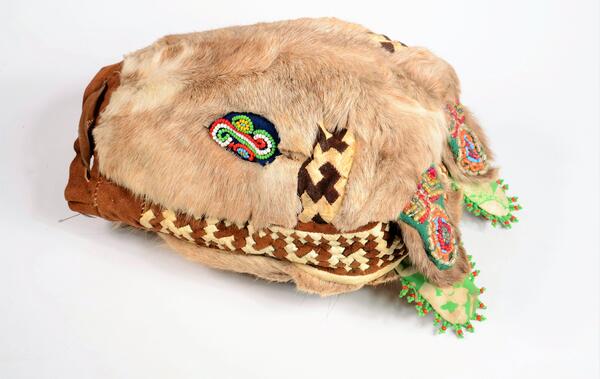Among the Ob-Ugrians, the beauty of a girl was judged by the quality and decoration of her clothes. From an early age, the girl was taught sewing and embroidery, and when growing up, she made outfits for herself. After marriage and the birth of children, the woman sewed for her whole family.
The first handicraft device was given to the girl at the age of six: her mother made a special box for her daughter from birch bark and fir bark. At first, dolls were kept in it, and after that, there were things necessary for sewing and embroidery: tendons, scissors, a thimble, a needle case with needles, and cloth shreds. For these purposes, there were also fur handbags called tuchans. A tuchan could be made not only from fur but also from leather or fabric. The handbag was decorated with embroidery and ornaments, which were supposed to protect the owner from evil spirits, and tassels with coins and beads were sewn on its sides. By the age of 13–15, the girl had several tuchans. The functions of a birch bark box for needlework and a fur bag are similar; however, going to a nomad camp or into the forest, a woman took a bag with her, because it is lighter and more convenient. In a tuchan, women kept not only sewing accessories but also her own amulets. Children’s umbilical cords were also put there.
The Museum of the Ob River houses a collection of traditional Khanty needlework bags. The exhibition “Ugra Heritage” displays the tuchan which was sewn in the 1980s in Punsi yurts located in the Nefteyugansk District. For its manufacture, two skins from the frontal part of the reindeer’s head were used. The skins were sewn with a pile outward, and an ornamented strip of rovduga — suede — was inserted between them. The rovduga stripe is decorated with a mosaic in the form of a horse’s head ornament. The eye holes are sewn up with a blue cloth and decorated with beads. Above the holes, the brow ridges are marked in the form of two ornamental stripes. Also on the tuchan there are two pairs of ears, embroidered with multi-colored beads.
Clasps were not made on the tuchan, instead, a drawstring was used, thanks to which the upper edge could be tightened. A tuchan was with the woman throughout her life, and even after the death of the owner, it was buried with her.
The first handicraft device was given to the girl at the age of six: her mother made a special box for her daughter from birch bark and fir bark. At first, dolls were kept in it, and after that, there were things necessary for sewing and embroidery: tendons, scissors, a thimble, a needle case with needles, and cloth shreds. For these purposes, there were also fur handbags called tuchans. A tuchan could be made not only from fur but also from leather or fabric. The handbag was decorated with embroidery and ornaments, which were supposed to protect the owner from evil spirits, and tassels with coins and beads were sewn on its sides. By the age of 13–15, the girl had several tuchans. The functions of a birch bark box for needlework and a fur bag are similar; however, going to a nomad camp or into the forest, a woman took a bag with her, because it is lighter and more convenient. In a tuchan, women kept not only sewing accessories but also her own amulets. Children’s umbilical cords were also put there.
The Museum of the Ob River houses a collection of traditional Khanty needlework bags. The exhibition “Ugra Heritage” displays the tuchan which was sewn in the 1980s in Punsi yurts located in the Nefteyugansk District. For its manufacture, two skins from the frontal part of the reindeer’s head were used. The skins were sewn with a pile outward, and an ornamented strip of rovduga — suede — was inserted between them. The rovduga stripe is decorated with a mosaic in the form of a horse’s head ornament. The eye holes are sewn up with a blue cloth and decorated with beads. Above the holes, the brow ridges are marked in the form of two ornamental stripes. Also on the tuchan there are two pairs of ears, embroidered with multi-colored beads.
Clasps were not made on the tuchan, instead, a drawstring was used, thanks to which the upper edge could be tightened. A tuchan was with the woman throughout her life, and even after the death of the owner, it was buried with her.


